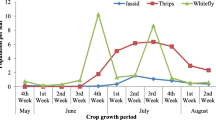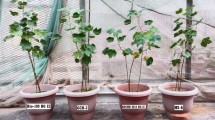Abstract
Ovipositional preference of cotton leafhopper,Amrasca biguttula biguttula (Ishida) on resistant and susceptible genotyps of cotton and okra was found under the influence of chemical components. The non-reducing sugars, tannins, silica and free gossypol in the leaves showed significant and negative correlation with the number of leafhopper eggs.
Similar content being viewed by others
References
Agarwal R A and Krishnananda N 1976 Preference to oviposition and antibiosis mechanisms to jassids (Amrasca devastans Dist) in cotton (Gossypium spp.);Symp. Biol. Hung. 1 13–22
Ahmad Z, Attique M R and Rashid A 1986 An estimate of the loss in cotton yield in Pakistan attributable to the jassidAmrasca devastans Dist;Crop Protection 5 105–108
AOAC 1970Official methods of analysis (Washington: Benjamin Franklin Station)
Barnett N M and Naylor A W 1969 Amino acid and protein metabolism in Bermuda grass during water stress;Plant Physiol. 41 1222–1230
Batra G R and Gupta D S 1970 Screening of varieties of cotton for resistance to jassid;Emp. Cotton Grow. Rev. 47 285–291
Beck S D and Schoonhoven L M 1980 Insect behaviour and plant resistance; inBreeding plants resistant to insects (eds) F G Maxwell and P R Jennings (New York: John Wiley) pp 115–136
Bhat M G, Joshi A B and Singh M 1984 Relative loss of seed cotton yield by jassid and bollworms in some cotton genotypes (Gossypium hirsutum L.);Indian J. Entomol. 46 165–173
Brewer J W, Capinera J L and Cates R G 1984 The defences of plants against insects; inInsect biology (ed) H E Evans (Massachusetts; Addison-Wesley Publishing Company) pp 236–251
Burns R E 1971 Method for estimation of tannin in grain sorghum;Agron. J. 63 511–512
Chakravorty S C and Sahni V M 1972 Biochemical basis of resistance to jassids (Empoasca spp.) inGossypium hirsutum cotton;Indian Agric. 16 45–48
Chan B G, Waiss A C and Lukefahr M 1978 Condensed tannin, an antibiotic chemical fromGossypium hirsutum;J. Insect Physiol. 24 113–118
Jayaraj S 1967 Studies on the effect of leafhopper infestation on the metabolism of carbohydrate and nitrogen in castor varieties in relation to their resistance toEmpoasca flavescens (F.);Indian J. Exp. Biol. 5 156–162
Joyce R J V 1961 Some factors affecting numbers ofEmpoasca lybica de Berg (Homoptera: Cicadellidae) infesting cotton in the Sudan Gezira;Bull. Entomol. Res. 52 191–232
Khan Z R and Agarwal R A 1984 Oviposition preference of jassid,Amrasca biguttula biguttula Ishida on cotton;J. Entomol. Res. 8 78–80
Kogan M 1975 Plant resistance in pest management; inIntroduction to insect pest management (eds) R L Metcalf and W H Luckmann (New York: John Wiley) pp 103–146
Mabbett T H, Nachapong N, Monglakul K and Makdaeng J 1984 Distribution on cotton ofAmrasca devastans andAyyaria chaetophora in relation to pest scouting techniques for Thailand;Trop. Pest. Manage. 30 133–141
Mathur J M S, Sharma N D and Singh M 1972 A rapid spectrophotometric method for determining free gossypol in cotton seeds;J. Food Sci. Technol. 9 138–139
Moffitt H R and Reynolds H T 1972 Bionomics ofEmpoasca solana De long on cotton in southern California;Hilgardia 41 247–297
Nuorteva P 1952 Die Nahrungapflanzenwhl der insekten im Lichte unternuchungen an Zikaden;Ann. Acad. Sci. Fenn. 19 1–90
Rawat R R and Sahu H R 1973 Estimation of losses in growth and yield of okra due toEmpoasca devastana andEarias spp;Indian J. Entomol. 38 293–295
Sandhu G S, Sharma B R, Singh B and Bhalla J S 1974 Source of resistance to jassid and whitefly in okra germplasm;Crop. Improv. 1 77–81
Sharma H C, Agarwal R A and Singh M 1982 Effect of some antibiotic compounds in cotton on post embryonic development of spotted bollworm (Earias vittella F.) and the mechanisms of resistance inGossypium arboreum;Proc. Indian Acad. Sci. (Anim. Sci.) 91 67–77
Sharma H C and Agarwal R A 1983 Role of some chemical components and leaf hairs in varietal resistance in cotton to jassid,Anrasca biguttula biguttula Ishida;J. Entomol. Res. 7 145–149
Singh R 1985Behavioural antibiosis mechanisms to jassid, Amrasca biguttula biguttula (Distant) and spotted bollworm, Earias vittella (Fabricius) in malvaceous crops, Ph.D. thesis, Indian Agricultural Research Institute, New Delhi
Singh R 1987a Bases of resistance in cotton toAmrasca biguttula biguttula (Ishida);J. Cotton Res. Dev. 1 131–140
Singh R 1987b Effect of okra fruit blocks, seeds and pericarp on post-embryonic development ofEarias vittella (Fab.) in relation to some phytochemicals of selected okra genotypes;Proc. Indian Acad. Sci. (Anim. Sci.) 96 361–367
Singh R 1988 Bases of resistance in okra toAmrasca biguttula biguttula;Indian J. Agric. Sci. 58 15–19
Somogyi M 1952 Notes on sugar determination;J. Biol. Chem. 195 19–23
Srinivasan M and Bhatia I S 1953 Carbohydrates of Agave Var Cruz MIPP;Biochem. J. 55 286–289
Tidke P M and Sane P V 1962 Jassid resistance and morphology of cotton leaf;Indian Cotton Grow. Rev. 16 324–327
Uthamasamy S 1986 Studies on resistance in okraAbelmoschus esculentus (L) Moench to the leaf hopper,Amrasca devastans (Dist.);Trop. Pest. Manage. 32 146–147
Yadav H C, Mittal K R and Singh H G 1967 Correlation studies between leaf mid rib structure and resistance to jassid (E. devastans Dist.) in cotton;Indian J. Agric. Sci. 37 495–497
Yemm E W and Cocking E C 1955 The determination of amino acids with ninhydrin;Analyst 80 209–213
Yemm E W and Willis A J 1954 The estimation of carbohydrates in plant extracts by anthron;Biochem. J. 57 508–514
Author information
Authors and Affiliations
Rights and permissions
About this article
Cite this article
Singh, R., Agarwal, R.A. Role of chemical components of resistant and susceptible genotypes of cotton and okra in ovipositional preference of cotton leafhopper. Proc. Indian Acad. Sci. (Anim. Sci.) 97, 545–550 (1988). https://doi.org/10.1007/BF03179556
Received:
Revised:
Issue Date:
DOI: https://doi.org/10.1007/BF03179556




